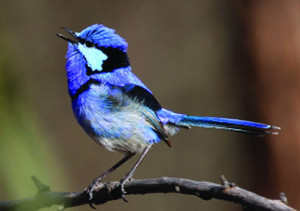A library of tweets (and howls and grunts)
An audio library is accumulating a world of animal sounds for science
 Sounds can transport us. The trumpet of an African forest elephant can take us to a noisy night in a reserve in the Central African Republic. The spiraling, alien trills of an Alaskan bearded seal can whisk us to the frigid Arctic Ocean. And the bell-like warble of the shiny black Kauai Oo can carry us back to Hawaii, to a time that no longer exists. The bird is now gone. Extinct. But thanks to a 1975 audio recording, its melodies live on.
Sounds can transport us. The trumpet of an African forest elephant can take us to a noisy night in a reserve in the Central African Republic. The spiraling, alien trills of an Alaskan bearded seal can whisk us to the frigid Arctic Ocean. And the bell-like warble of the shiny black Kauai Oo can carry us back to Hawaii, to a time that no longer exists. The bird is now gone. Extinct. But thanks to a 1975 audio recording, its melodies live on.
These sounds and more form part of the Macaulay Library at Cornell University in Ithaca, N.Y. It’s the world’s largest — and oldest — repository of animal sounds. The Macaulay archives include nearly 200,000 animal vocalizations, including some with video clips.
For a long time, accessing the library’s 84 years of audio recordings took time and patience. But in 2013 the library completed a 12-year effort to convert its collections into a digital format. Now anyone with Internet access can listen to clips from the library. All it takes are a few clicks of a mouse.
The collection started with just bird songs. That explains why it’s housed at Cornell’s Ornithology Lab (ornithology is the study of birds). But the library now also includes the vocal stylings of sea- and land-based mammals, reptiles, amphibians and even insects, says Macaulay’s director, Michael Webster.
Volunteers and researchers tromp through marshes, up mountains and across meadows — wherever animals are — to record their calls. Each year, the library adds another 4,000 to 5,000 recordings from around the world.
Saving all of those chirps, roars, hisses, hums and barks is serious science. Animals use sounds to attract mates, to warn community members about predators and essentially to chat, Webster explains. So each recording can reveal a wealth of information about the behavior and social interactions of a species.
Scientists can use the recordings to test theories about the evolution of animal behaviors and the ways animals talk to each other. Sometimes scientists even play back recorded sounds in the field to lure animals and to test their responses. For example, an animal may respond to a recording by approaching out of curiosity — or by sounding a warning.
In this way, biologists study animal sounds to “unlock sort of the secret code they use to communicate,” Webster says. For that reason, the Macaulay Library’s digital archive contains treasures for anyone interested in how animals communicate.
The library’s recordings have even played a role in more than 600 scientific studies, Webster says. These studies include a surprising discovery by scientists in Costa Rica. There, the experts found it isn’t just male leaf-litter frogs that trill and squeak to attract mates — the females squeak right back. It’s something the females in just 12 other frog species are known to do.
And in California, British scientists learned the endangered San Joaquin kit fox doesn’t bark to mark its territory. Instead, the fox does so to attract mates.
Read on to find out how biologists have used Macaulay Library recordings to put Australia’s fairy-wrens on high alert, to identify unseen wolves and to help save an endangered population of Caribbean birds.
Listening to show-offs
Birds often sound alarms when a predator approaches. These calls alert others to the danger. Birds also serenade potential mates. You might expect that their warning and courting calls would differ dramatically. Yet Emma Greig discovered that a male splendid fairy-wren (yes, that’s the real name of this strikingly blue bird) may use its danger alert to woo a female.
She wondered if other Australian species of fairy-wren did the same thing. Eventually, she tapped the Macaulay Library to further her research. But more about that later.
Fairy-wrens are small birds. Those found throughout Australia come in a range of colors. Some are a riot of blues and purples. Others are mostly brown, with a velvety blue-and-black crown. They are among the favorites of many Australian birdwatchers.
Greig has studied these birds in Australia since 2005, including as part of her PhD research. (She now works with Project FeederWatch, a bird survey program based in Ithaca.) Much of her research focused on how the birds respond to the calls of predators, including a species called the butcherbird.
Butcherbirds get their name from the way they impale their prey on thorns or branches. They use these natural hooks to store their meal until they’re ready to dine. These large songbirds eat lizards, insects, fruit and small birds — including fairy-wrens.
After hearing the call of one of these scary predators, a splendid fairy-wren male will sing boldly. One might expect it does so to warn others of his species to take cover. But that’s not what Greig uncovered.
Male fairy-wrens instead were trying to impress females with their bravado, she learned. It’s as if the males were calling out to a potential mate, right in front of a bully, saying: “Hey, I know it’s scary here, but I’m not afraid.”
This show-off gesture appears to work. Female fairy-wrens tend to become more alert and often reply back to the singing males, Greig found. That made the biologist curious: Do all species of fairy-wren do this?
Soon Greig began traveling to the ends of Australia to collect data on all nine species of its fairy-wrens. She flew to remote sites to gather data on one of the rarest: birds known as the lovely fairy-wren. She tromped through riparian woodlands to learn more about the purple-crowned fairy-wren. And she once worked beside a gas station where she had tracked down some red-backed fairy-wrens. Each species lived in a distinctly different habitat. Not surprisingly, each also faced very different predators.
Near rivers, the main predator might be a kookaburra, a bird in the kingfisher group. Meanwhile, a hawk might be the primary threat in grasslands. And this is where the Macaulay Library recordings came in handy.
Greig would play back the recording of a predator’s call for each type of fairy-wren. Then she would observe its response. “I traveled all over the continent,” Greig recalls. Using Macaulay’s archived bird calls allowed her “to create a playback experiment that was more realistic than anything I could have created using my own recordings.”
In the February 2014 Animal Behaviour, Greig and Webster, the Macaulay Library’s director, reported that the splendid fairy-wren’s bravado was not unique. Males of six other species also trilled in a show-off way after hearing a predator’s call.
Picked out of the pack
Many experts study the important roles that wolves play in ecosystems. Spotting, identifying and tracking any particular wolf, however, can be challenging. That prompted Holly Root-Gutteridge to look for a better way to survey these wide-ranging predators. She decided to focus on their howling. A wolf howl can carry more than 10 kilometers (6 miles).
As part of her PhD research at England’s Nottingham Trent University, she made use of wolf recordings from the Macaulay Library. Her study finds that researchers can identify an individual wolf — even when it’s out of sight — just by the sound of its howl.
We all have an ear for voices. “You know it’s your mom when she’s on the phone,” Root-Gutteridge explains. The same is true for animals, including wolves. “The wolf knows it’s his friends when he hears their howls,” she observes.
With people, physics can make voice identification an exact science. Experts can take a snippet of conversation, and then match the patterns in that speech to the patterns in a known individual’s voice. Root-Gutteridge wondered if each wolf’s voice patterns were just as distinctive. If so, she could “fingerprint” the howlings of individual wolves.
To test her theory, she and her colleagues designed a computer program. It converted a recording of a wolf’s howls, second-by-second, into a pattern. Its wavelike patterns mapped variations in pitch and volume. Root-Gutteridge then used the computer program to compare the sounds that each wolf made.
She started by studying 89 recordings. These came from six captive wolves. Her computer analysis created a digital display of the vocal changes in each howl. Scientists refer to such patterns as spectra. A spectrogram is simply a visual display of a particular vocal pattern.
A spectrogram (top) created from a Macaulay Library howl of a wolf nicknamed Alexander. The bottom graph displays the raw sound before Holly Root-Gutteridge used her computer program to clean it up. The lines are the frequency, or layers, of sound pitch. The color intensity reflects how loud the wolf howled.
Spectrograms charted how the volume and pitch varied in each howl. These mapped “what they’re singing, the frequency and how loud they’re singing it,” Root-Gutteridge says.
By working with captive wolves — animals held in an enclosure — she knew exactly which wolf made what sound. That allowed Root-Gutteridge to test her technique. It accurately identified the wolf behind each howl 100 percent of the time. Next, she moved her experiment to recordings of wild wolves.
Wild wolves can howl in a chorus. That makes it difficult to pick out an individual. A gurgling river or the whistling wind might mask howls somewhat. To test her program on wolf calls in a natural environment, the biologist turned to archived recordings. These included some of wolves howling together.
In all, she analyzed 179 recordings. The Macaulay Library supplied 91. Another 85 came from the British Library Sound Archive. Yet three more came from an expert who had recorded wolf howls in Minnesota. Root-Gutteridge had to account for differences among the recordings. These included variations in the equipment used, background noise and whether the wolves howled alone or as a pack.
Ultimately she analyzed 67 individual howls from 10 individual animals — again identifying each wolf with 100 percent accuracy. She also analyzed 112 chorus howls from 109 wolves. And even here her identification accuracy was good — Root-Gutteridge could pick out individual wolves with near-100 percent accuracy. She and six colleagues described their findings earlier this year in Bioacoustics.
Root-Gutteridge hopes to one day take any recording of wolves in the wild and identify how many distinct voices are present. Better yet, she would like to know if “they’re the same wolves you had two nights ago — or even last summer.”
Calling all cahows
Bermuda’s national bird is the cahow (Ke HOW), also known as the Bermuda petrel. Like the albatross, this dark-gray-and-white bird spends most of its life soaring over the sea. But there aren’t many cahows left. The beleaguered animal — for centuries thought extinct — has had a tough time holding on. But over the past decade, it has been staging a slow comeback. And the Macaulay Library has played a notable role in that recovery effort.
It’s estimated that more than 500,000 pairs of cahows once soared Bermuda’s skies from January through June. That’s when these birds returned to land to breed. At night, they would wheel through the sky calling out to potential mates. Early European visitors reported hearing these eerie moaning cries through the dark. For that reason, sailors dubbed the islands of Bermuda the “Isles of the Devils.”
But things changed soon after the first British settlers arrived in 1609. Faced with starvation, the settlers ate many adult cahows. Animals introduced by the settlers, including cats and rats, raided the seabirds’ nests. Since cahows nested in burrows on the ground, their eggs and chicks proved easy targets. Within a dozen years, the cahows had all but vanished from the face of the Earth. Indeed, for the next 300 years, people presumed the cahow was extinct.
Then, in 1951, scientists discovered 18 active cahow nests on four mini-islands, or islets, in Bermuda’s Castle Harbour. Since then, biologists, including Jeremy Madeiros of Bemuda’s Cahow Recovery Project, have been trying to protect the species and restore its population.
Cahow chicks fledge — leave the nest — about three months after hatching. They won’t return for three to five years, and then only to breed. At that time, the birds will seek out the same site where they had hatched.
Sometimes, changes can leave a traditional nesting site unusable or risky. That’s what happened after Hurricane Fabian struck Bermuda in the fall of 2003. The Category 3 storm packed winds of more than 193 kilometers (120 miles) per hour. The strongest hurricane to hit Bermuda in 40 years, it washed over three of the four breeding islets. The storm destroyed nine burrows and damaged many more.
Madeiros decided to move the remaining cahow nests to higher and safer ground. To lure the birds to the new sites, he would have to somehow convince the birds at sea that they needed to abandon their old nesting sites.
This is where the Macaulay Library helped. It provided biologists with recorded cahow calls, notes Greg Budney. He’s the library’s audio curator. The goal was to draw the returning birds to their new homes by sending out welcoming calls.
Stephen Kress, of Audubon’s Seabird Restoration Program in Ithaca, N.Y., had pioneered the basic idea with Maine puffins in 1973. Puffins had bred on coastal islands until people hunted the birds to local extinction in the 1800s. Kress headed a project to bring breeding puffins back to these Maine islands.
So he and other scientists built nests on the islands. Then they brought puffin chicks down to these Maine islands from Newfoundland, Canada. The biologists hoped the fledglings would view the islands as home — and eventually return there when, as adults, the time came to breed. To help the puffins recognize the site, Kress set out decoys. These resembled the puffins he was trying to attract.
Nor was that the end of it. Kress also needed to attract terns to keep away gulls. Those gulls would otherwise eat puffin eggs and chicks. For that, he again used decoys — this time resembling terns. And nearby, he played recordings of tern calls from the Macaulay Library.
Clearly, kress says, introducing seabirds to new nesting sites isn’t easy. It takes persistence and patience.
After learning about the puffin project, Madeiros suspected the same strategy might work for Bermuda’s endangered petrel. He worked with Kress to set up a plan and then contacted the Macaulay Library. The library’s Mark Reaves traveled to Bermuda to make night recordings of courting cahows.
Madeiros’ team then broadcast those cahow-courtship calls from a Bermuda islet called Horn Rock. That’s where the biologists had constructed artificial nest burrows. And the birds indeed took notice. At once, they moved into the new digs.
So far, the cahow relocation project appears to be working, but slowly. Last year, Madeiros reported that a record 105 nesting pairs had been spotted on six islands. And 53 of their chicks survived to fly to sea.
I thought I heard a tweeting bird
Chances are that you already have heard sounds from the Macaulay Library. Museums often use them in exhibits. Some books include snippets of their sounds.
Modified recordings from the archives have been used in such major motion pictures as Jurassic Park, Ratatouille and How To Train Your Dragon.
The recordings also lend an authentic voice to the plush toy cardinals and other birds sold in many museum and park gift shops.
The library’s overall goal, however, “is to help people understand and conserve nature,” explains Webster, its director.
“By using their ears and listening to the sounds of nature,” he says, “we can help people better understand the natural world around them and engage with it.”
















Recent Comments